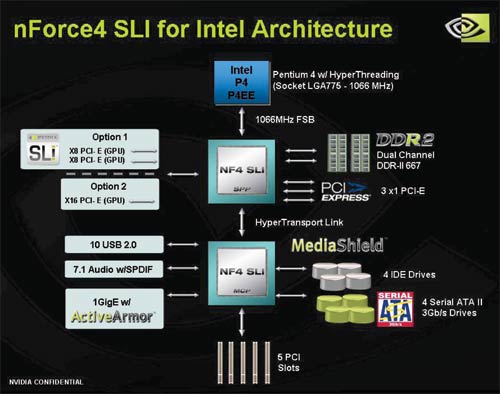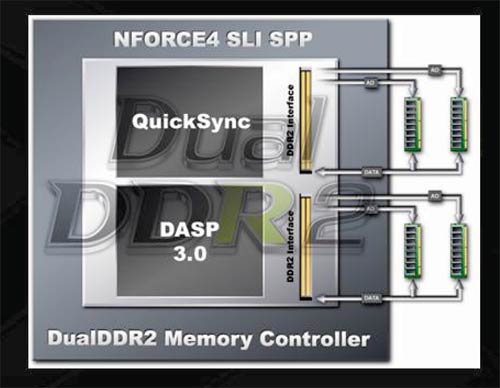Dual Core Intel Platform Shootout - NVIDIA nForce4 vs. Intel 955X
by Anand Lal Shimpi on April 14, 2005 1:01 PM EST- Posted in
- CPUs
NVIDIA's nForce4 SLI Intel Edition Chipset
As we've indicated in the past, NVIDIA's first Intel chipset is very similar to their nForce4 AMD chipset, with a couple of exceptions. For starters, the Intel Edition chipset is made up of two chips, compared to the AMD chipset's one. The reasoning is simple: with AMD's architecture, NVIDIA needn't include a memory controller in their chipset, which cuts down on overall die size quite a bit. With the Intel Edition, we see the first new memory controller that NVIDIA has introduced since nForce2.

Remember DASP? NVIDIA's Dynamic Adaptive Speculative Pre-Processor is back in nForce4 Intel Edition, but this time around, the competition is much stronger. DASP is a hardware pre-fetch engine that resides within the memory controller and attempts to pre-fetch data into a small amount of cache on the chipset, which NVIDIA's algorithms determine will be used by the CPU in the future. Intel has a similar technology in their 955X chipset, although it's not something they have branded or marketed. Depending on how aggressive NVIDIA's DASP is, it could make good use of the extra memory bandwidth offered by its dual channel DDR2-533/667 memory bus.

NVIDIA also boasts a dedicated address bus per DIMM slot with the nForce4; however, this seems to be a feature also supported by Intel, so there isn't much advantage over the competition here.
In their final memory controller optimization, NVIDIA's QuickSync claims to be able to reduce memory latency when operating in multiple clock domains (e.g. 800MHz FSB, but 533MHz memory bus). Later in this article, we'll find out exactly how aggressive NVIDIA's memory controller truly is.
The nForce4 SLI Intel Edition chipset supports both 800 and 1066MHz FSBs, just like the 955X - however, NVIDIA also indicated that if Intel were to increase the FSB frequency, they would be ready.
Unlike the 955X, NVIDIA only supports 3 PCI Express x1 slots. However, NVIDIA does offer two PATA channels, compared to Intel's single PATA channel. NVIDIA also offers more USB 2.0 ports (10 vs 8). NVIDIA does not support Intel's HD Audio spec, so you're stuck with AC'97 on the nForce4 SLI.










96 Comments
View All Comments
stevty2889 - Saturday, April 16, 2005 - link
PeteRoy - Saturday, April 16, 2005 - link
Stevty, if you really work for Intel you would know that Intel has a specification for what case to use with 3ghz/90nm processors.Here's a link:
http://support.intel.com/support/processors/pentiu...
stevty2889 - Saturday, April 16, 2005 - link
I think Questar is cramitpals nemisis..Quester I work for Intel, even Intel knows that the prescott has heat issues, and that for most applications right now, AMD is winning in price/performance...having to use water cooling to get a chip to run at stock speed without throttling is a pretty major heat issue if you ask me..even a thermalright XP-120 couldn't keep my 3.4 prescott from throttling at stock speeds, my 3.2 ES, and 2.8 didn't have as much of an issue, but some of the prescotts are running WAY too hot..
stephenbrooks - Friday, April 15, 2005 - link
^^ I was just searching all the previous 81 comments for the word "Soviet" in disbelief. Guess we've spoiled it now though.Houdani - Friday, April 15, 2005 - link
Anyone else miss the days of only bickering about:"The message is clear..."
"First!"
"In Soviet Russia..."
Ah, memories. Feels like only yesterday.
fitten - Friday, April 15, 2005 - link
Well... it would be pretty stupid of a company to not roll with the punches. I'd rather see them shape their direction as they have that be rigid (which means they wouldn't compete anymore).The reason no one jumped at 64bits in x86 land is because the volume of 64bit processors out there wasn't worth the effort. So... 100,000 64bit systems are out there... compare that with over 1000X that number of 32bit only systems. Which would you target if you were developing software? Now that 64bit will be mainstream, the market will move that way.
In addition, mom/pop won't see any real benefit from 64bit. There will be marginal speed benefits to having more general purpose registers, but that would have been the case in 32bit land. I doubt they are doing things that require more than 4G of memory, either. The only other real speed benefits are when you are manipulating 64bit integers and there just aren't that many apps that mom/pop use that need that kind of range.
I like AMD as well (all 5 of my personal desktops have them) but I'm not a blind follower. It's nice to be excited about technology but don't let it become a religion. If Intel released a better processor than AMD, I wouldn't hesitate to buy those instead.
Questar - Friday, April 15, 2005 - link
Jeez, how many times do I have to repeat myself?We don't qualify processors, we qualify systems!
Let me provide you with some links:
http://h10010.www1.hp.com/wwpc/us/en/sm/WF02d/1245...
http://www1.us.dell.com/content/products/category....
http://www-132.ibm.com/webapp/wcs/stores/servlet/C...
Do you see any AMD based business computer lines from these vendors?
I'll stop you from having to post a link to Gateway, or somebody even smaller. They don't provide the services we contract for when we buy systems. Again, it's about the entire system, and everything that is wrapped around it.
mlittl3 - Friday, April 15, 2005 - link
#78,And I assume that means that in your companies infinite wisdom that AMD processors could never be qualified in such a way and even though AMD has tried to convince your company otherwise, you don't think it is the right time to stop kissing Intel's ass.
You don't by any chance work for a little company called Dell do you?
Questar - Friday, April 15, 2005 - link
Funny, I never said anything about Intel or AMD product roadmaps.I said vendor product roadmaps.
For example, I know exactly when my current desktop system is going end of life, and I know what product will replace it. We will have POC units in our labs for our desktop engineering people to work with about 90 days before GA. They will buld the OS image for the systems, do extensive application testing, standardize the bios version and config (our PC vendor ships our systems preconfigured to our specifications). Everything that's different about the system from a technician standpoint will be documented. (Such as if you replace a system board, this is how to program the bios with the systems' asset tag). Our management systems will be updated with any changes that are needed to support the new systems.
In the interim, I'll stock up with about a thousand units of the old system to bridge over the transition (four week supply). This is SOP for any large corporation. Every Fortune 500 that has centralized IT functions do it this way.
This allows me to plan the resources that are needed to transition to the new system.
smn198 - Friday, April 15, 2005 - link
Questar is a troll. See http://www.google.co.uk/search?sourceid=mozclient&...Tries to stir up trouble all the time. Best to just ignore such people.